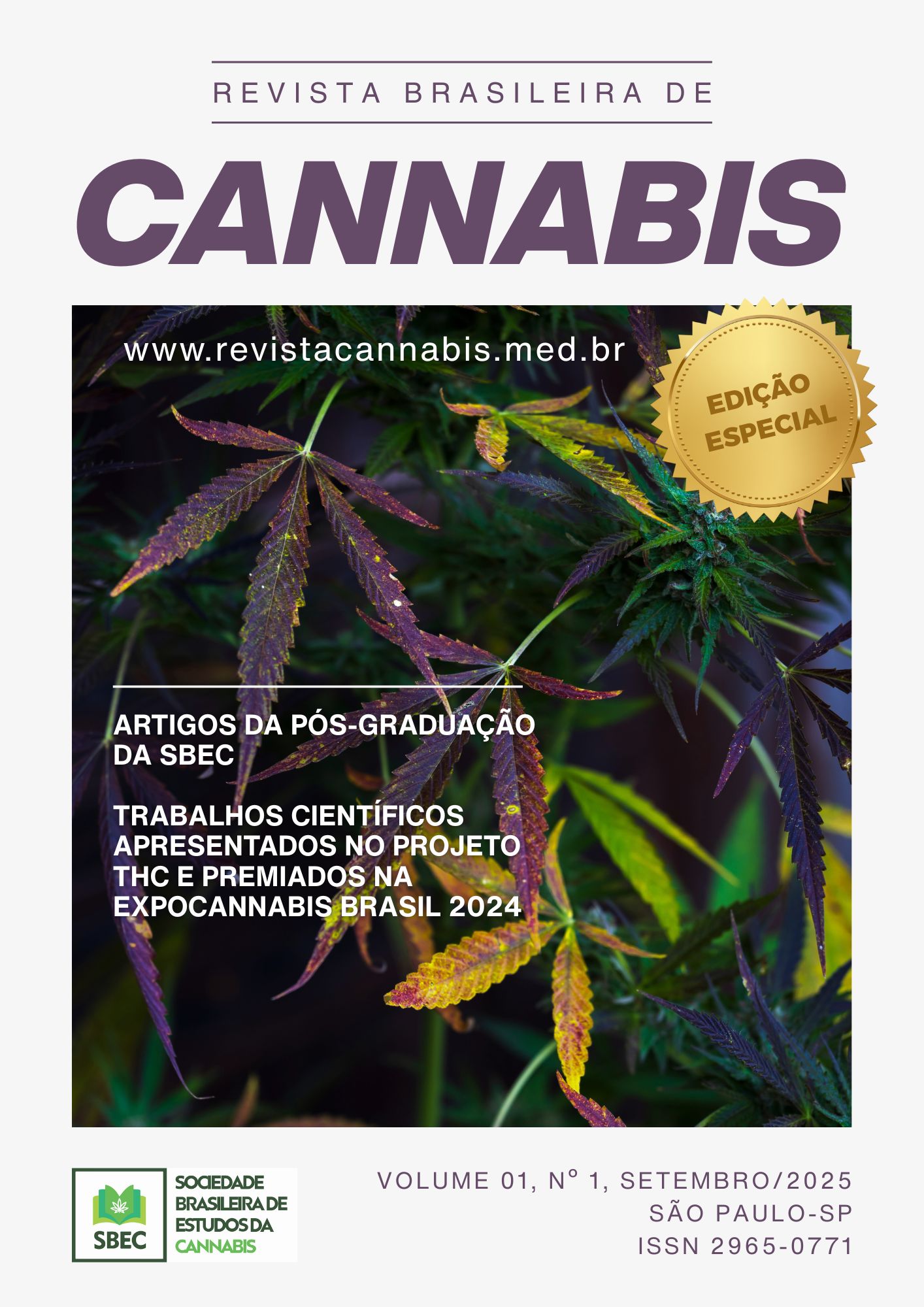EXTRACTION AND ANALYSIS OF TERPENES FROM THE ESSENTIAL OIL OF LEAVES AND STEMS OF CANNABIS SATIVA L
DOI:
https://doi.org/10.58731/2965-0771.2025.105Abstract
This study aimed to extract the essential oil from the leaves and stems of Cannabis sativa L. and evaluate its volatile component profile using gas chromatography coupled with mass spectrometry (GCMS). The essential oil was obtained through hydrodistillation using a Clevenger apparatus from leaves and stems of six mature plants of the Fedtonic variety, cultivated in a greenhouse at the Cannabis Development and Innovation Hub (PODICAN) of the Federal University of Santa Catarina, Curitibanos Campus. The yield of essential oil from the leaves was 0.33%, higher than previously reported in the literature. The main compounds identified in the leaves were bisabolol (25.76%) and trans-caryophyllene (18.96%), while in the stems, bisabolol (43.74%) and cannabidiol (CBD; 9.08%) were prominent. The variation in terpene composition suggests different therapeutic and commercial applications for each part of the plant. This study highlights the importance of utilizing typically discarded parts of the plant to maximize its economic and environmental potential, promoting innovation and sustainability.
Keywords: Essential oil; Terpenes; Cannabis.
References
1. Adams, R. P. Identification of essential oil components by gas chromatography/mass spectrometry (4th ed.). Carol Stream, IL: Allured Publishing Corp 2007; https://doi.org/10.1016/j.jasms.2007.01.001.
2. Apolônio, B. M., Marques, M. B., Fonseca, P. M. M., & Lima, T. M. O potencial terapêutico do hidrolato de plantas medicinais nos tratamentos estéticos. Peer Review 2023; 5(24), 217–232. https://doi.org/10.53660/1443.prw2939.
3. Ascrizzi, R., Breemen, N. V., Carter, B., Ferrini, F., & Giardina, A. Inflorescence yield, essential oil composition and antioxidant activity of Cannabis sativa L. cv. ‘Futura 75’ in a multilocation and on-farm study. Agriculture 2024; 14(2), 225.
4. Bizzo, H. R., Hovell, A. M. C., & Rezende, C. M. Óleos essenciais no Brasil: aspectos gerais, desenvolvimento e perspectivas. Química Nova 2009; 32(3), 588–594. https://doi.org/10.1590/S0100-40422009000300005.
5. Jin, D., Dai, K., Xie, Z., Chen, J., Wang, J., & Zhao, M. Secondary metabolites profiled in cannabis inflorescences, leaves, stem barks, and roots for medicinal purposes. Scientific Reports 2020; 10, 3309. https://doi.org/10.1038/s41598-020-60172-6.
6. Naz, S., Ahmed, W., & Ramadan, M. F. Cannabis sativa leaf essential oil fractions and bioactive compounds: chemistry, functionality and health-enhancing traits. Food Measure 2023; 17, 4575–4593. 11 https://doi.org/10.1007/s11694-023-01963-z.
7. Noppawan, P., Bainier, C., Lanot, A., McQueen-Mason, S., Supanchaiyamat, N., Attard, T. M., & Hunt, A. J. Effect of harvest time on the compositional changes in essential oils, cannabinoids, and waxes of hemp (Cannabis sativa L.). Royal Society Open Science 2022; 9(211699). https://doi.org/10.6084/m9.figshare.c.6011489.
8. Russo, E. B. Taming THC: Potential cannabis synergy and phytocannabinoid-terpenoid entourage effects. British Journal of Pharmacology 2011; 163(7), 1344-1364. https://doi.org/10.1111/j.1476-5381.2011.01238.x.
United Nations Commodity Trade Statistics Database. Base de dados Contrade da ONU 2023. Recuperado de https://comtradeplus.un.org/TradeFlow?Frequency=A&Flows=X&CommodityCodes=330129&Partners=0&Reporters=all&period=2023&AggregateBy=none&BreakdownMode=plus.
9. Xu, J., Bai, M., Song, H., & Zhou, G. Hemp (Cannabis sativa subsp. sativa) chemical composition and the application of hempseeds in food formulations. Plant Foods for Human Nutrition 2022; 77, 504–513. https://doi.org/10.1007/s11130-022-01013-x .
Downloads
Published
How to Cite
Issue
Section
License
Copyright (c) 2025 Revista Brasileira de Cannabis

This work is licensed under a Creative Commons Attribution 4.0 International License.





